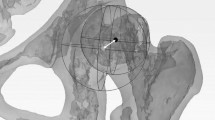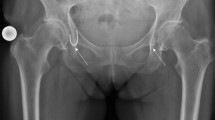Summary
In prosthetic surgery of the hip joint it is essential to recenter the hip to recreate the leverage of the gluteus medius muscle. Determination of the center of rotation of the hip is difficult if both hip joints have been destroyed. On the basis of 70 frontal radiographs of the hip in the standing position, the authors measured the position of the center of the femoral head in relation to Köhler's line and the TD line joining the two radiological Us (“tear-drops”). On the same radiograph they defined the horizontal and vertical indices. The descriptive analysis of these parameters stresses the influence of sex on the coordinates of the center of rotation of the hip. The authors demonstrated the statistical correlations between the coordinates of this center of rotation of the joint and certain horizontal and vertical indices. It emerged that knowledge of these indices suffices to define the theoretic position of the center of rotation. The method is compared with other principles set out in the literature. The procedure has a clinical application in the context of preoperative planning of prosthetic reconstruction of the acetabulum, whenever it is destroyed bilaterally (after trauma, in congenital dislocation or acetabular loosening, etc).
Résumé
En chirurgie prothétique de l'articulation coxo-fémorale, il est fondamental de recentrer la hanche pour recréer la balance du muscle moyen fessier. La détermination du centre de rotation de la hanche est difficile si les deux articulations coxo-fémorales sont détruites. A partir de 70 radiographies du bassin de face debout, les auteurs mesurent la position du centre de la tête fémorale par rapport à la ligne de Kohler et par rapport à la ligne TD, unissant les deux U radiologiques. Sur cette même radiographie, ils définissent des index horizontaux et des index verticaux. L'analyse descriptive de ces paramètres met l'accent sur l'influence du sexe sur les coordonnées du centre de rotation de la hanche. Les auteurs mettent en évidence des corrélations statistiques entre les coordonnées de ce centre de rotation de l'articulation et certains index horizontaux et verticaux. Il en résulte que la connaissance de ces index suffit à définir la position théorique du centre de rotation. La méthode est comparée aux autres principes énoncés dans la littérature. Le procédé trouve sa place en clinique, dans le cadre de la planification pré-opératoire des reconstructions prothétiques de l'acétabulum, chaque fois qu'il est détruit de façon bilatérale (séquelle traumatique, luxation congénitale, descellement acétabulaire, etc.).
Similar content being viewed by others
References
Crowe J, Mani J, Ranawat C (1979) Total hip replacement in congenital dislocation and dysplasia of the hip. J Bone Jt Surg, 67A: 1074–1085
Lewalle J, Hebrant R (1990) Etude multicentrique belge des résultats des arthroplasties totales pour luxation congénitale invétérée de hanche. Acta Orthop Belg, 56: 395–405
Pierchon F, Migaud H, Fontaine C, Duquennoy A (1993) Détermination théorique du centre de l'art. coxo-fémorale en cas de dysplasie ou de luxation bilatérale de hanche. Rev Chir Orthop, 79, 281–284
Postel M, Kerboul M, Evrard J, Courpied JP (1985) Arthroplastie totale de hanche. Springer-Verlag, Berlin, Heidelberg
Ranawat CS, Dorr LD, Inglis AE (1980) Total hip arthroplasty in protrusio acetabuli of rheumatoid arthritis. J Bone Jt Surg, 62A: 1059–1065
Sutherland CJ, Wilde AH, Borden LS (1982) A ten years follow-up of one hundred consecutive Müller curved stem total hip replacement arthroplasties. J Bone Jt Surg, 64A: 970–982
Vidal J, Fishbach C, Orst G (1982) Place de la prothèse totale recentrée dans le traitement de certaines luxations invétérées de hanche. Rev Chir Orthop, 68, 216–223
Author information
Authors and Affiliations
Rights and permissions
About this article
Cite this article
Fessy, M.H., N'Diaye, A., Carret, J.P. et al. Locating the center of rotation of the hip. Surg Radiol Anat 21 (Suppl 4), 247–250 (1999). https://doi.org/10.1007/BF01631394
Received:
Accepted:
Issue Date:
DOI: https://doi.org/10.1007/BF01631394




